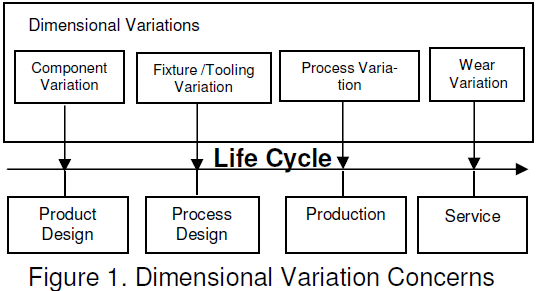/figure-1-dimensional-variation-analysis-concerns.png)
 Dimensional Variation Analysis Provides Value Across the Entire Product Life Cycle
Dimensional Variation Analysis Provides Value Across the Entire Product Life Cycle
These days, manufacturers are looking at dimensional variation analysis as a primary tool in gaining competitive advantages for managing manufacturing costs and quality. With profit margins getting smaller, and competition getting bigger, companies use dimensional analysis to support lean manufacturing processes in order to reduce waste, scrap and warranty issues caused by non-conformances, variation and unexpected assembly defects. This is letting companies effectively increase profits by simply improving current processes and reducing costs that have historically been considered sunk.
/figure-1-dimensional-variation-analysis-concerns.png)
To effectively apply dimensional analysis as part of product life cycle management (PLM) across the enterprise, it is key to connect the various teams and processes. This, of course, is always a challenge, as teams that are used to working independently struggle to work in tandem.
DCS proposes a method of bringing the enterprise's different teams together through a Closed-Loop approach to PLM. Oftentimes companies use similar methods, but do so manually. DCS's approach automates this process, streamlining it from Product Design through Production and into Service, then bringing information and experience gained back into improving Product Design of the current Product and future ones.
Let's begin with variation for an assembled product, where the dimensional variation directly affects the quality and functionality in the life of the product. Variation can cause additional wear, part failure, improper fit and function and possible product failure. For this example we have a Winshield Wiper Motor below in Figure 2.
/figure-2-wiper-motor-model-3dcs-catia.png?width=261&height=195&name=figure-2-wiper-motor-model-3dcs-catia.png)
In this assembled product, dimensional analysis is performed to address the following concerns:
If a product evolution is included, then the life cycle of a product is really a 'closed-loop' as shown in Figure 3
/figure-3-dimensional-variation-life-cycle-plm-product-evolution.png?width=424&height=343&name=figure-3-dimensional-variation-life-cycle-plm-product-evolution.png)
In the example of Figure 2, the quality evaluation will include the information on motor failure rate and useful life. This evaluation will provide direction for future improvement of the product.
To better promote dimensional managment for manufacturing industries, as noted before, DCS proposes a 'Closed-Loop' approach in managing dimensional variation. An example of this is shown below:
/figure-4-dimensional-management-closed-loop-3dcs-1.png?width=373&name=figure-4-dimensional-management-closed-loop-3dcs-1.png)
NOTE HERE: GDM is now QDM! Take a look at our youtube channel to find out about its new features https://www.youtube.com/playlist?list=PL5BD34C68C96922D6
Let's start at the beginning. Okay, that isn't a good way to put it. My math isn't the greatest, but most circles that I've seen do not have a beginning. That's important to note, as most companies believe that they have to start at the beginning, but the key to using an automated system like this is that you can start anywhere. The important thing is to start somewhere, and build off of that.
In this particular instance, we're going to start at Dimensional Variation Analysis.
Measure Generator is a function in 3DCS that generates measurements of sleected features. 3DCS can then export the nominal feature position and simulation results as a CMM-DEV file. This data assists in developing measurment plans, input templates for QDM-3D (formerly GDM 3D), and output data from QDM Web. Usage links are shown in Figure 5.
/figure-5-linking-tools-together-3dcs-qdm.png)
Here is a snap shot of the Measure Generator interface. This is a great way to create measurement plans right out of 3DCS, allowing dimensional analysis of attributes that are key contributors to variation and honing in on those particular features for the measurement plan.
/figure-6-measure-generator-3dcs-measurement-plan-authoring.png)
With the Measure Generator, measurements can be output in the X, Y and Z direction, an associated direction or even a project plane direction. This allows the user to create detailed plans for use in CMM and other measurement systems.
This is just one step in the closed loop, connecting dimensional analysis in product design to metrology and quality during production.
Keep your eyes out for more, and in the meantime, download the short pdf of this article, based on one of DCS's DE Focus articles (join our newsletter here to get them each month http://www.3dcs.com/mailing-list.html).
These Stories on 3DCS
No Comments Yet
Let us know what you think